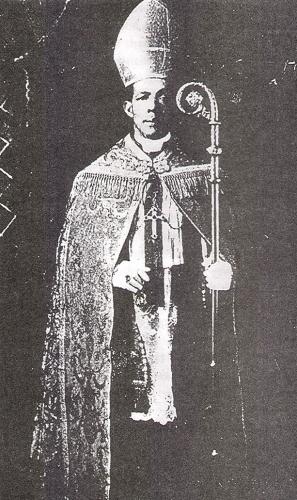George Alexander McGuire was a bishop and founder of the African Orthodox Church, as well as chaplain-general of the Universal Negro Improvement Association (UNIA). McGuire was born on March 26, 1866 at Sweets, Antigua, in the Caribbean. He was educated in the local school system, then at the Antigua branch of Mico College for teachers and at the Moravian Miskey Seminary in the Danish West Indies. From 1888 to 1894 McGuire was pastor of a Moravian Church in the Danish West Indies
In 1894, McGuire arrived in the United States and initially joined the African Methodist Episcopal Church. On January 2, 1895, however McGuire joined the Episcopal Church and two years later became an ordained priest. McGuire led small mostly black Episcopal churches in Cincinnati, Richmond, Virginia and Philadelphia.
From 1905 to 1909, McGuire served as Archdeacon for Colored Work in Arkansas where he zealously labored to increase the number of missions from one to nine. He also encountered opposition from the local Episcopal bishop who believed blacks should be separated from whites and placed in their own church jurisdiction. Eventually McGuire resigned and moved to Cambridge Massachusetts where he established St. Bartholomew’s Church for West Indians living in the Boston area. While in Cambridge, McGuire studied at Boston College of Physicians and Surgeons, receiving his M.D. degree in 1910. When his small church was not recognized by the Episcopalian diocese, McGuire resigned in 1911. As he traveled across the U.S. he became even more discouraged by the dismal prospects of blacks in the Episcopal Church and left the denomination.
In 1913 McGuire returned to the West Indies, settling in British-controlled Antigua to care for his sick mother. While there he volunteered at a local perish and gained acclaim for practicing medicine on the island. When a strike of local sugar cane workers led to rioting and burning of the sugar cane fields, British colonial officials urged local and religious leaders to oppose the strikes but McGuire refused and urged them to provide the workers with decent, living wages.
McGuire returned to the United State in 1918 and soon afterwards joined the (UNIA). Marcus Garvey, the UNIA’s president appointed him Chaplain-general of the organization. On September 2, 1921 the UNIA created the African Orthodox Church and appointed McGuire as bishop. The church, based on traditional Catholic doctrines, was open to all but under complete black leadership and control. McGuire declared to his followers: “You must forget the white gods. Erase the white gods from your hearts. We must go back to the native church, to our own true God.”
Shortly after the UNIA convention in August 1924, McGuire broke with Garvey and focused on expanding his church which mostly attracted Anglican West Indian immigrants. At the time of his death in 1934, the African Orthodox church claimed over 30,000 members, fifty clergy and thirty churches located on three continents: North America, South America and Africa.


